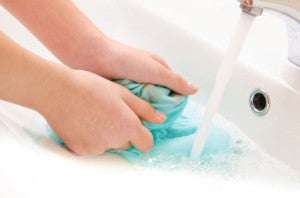Hypothetical scenario: There’s a blackout…or, an apocalypse – and you need to get some stubborn stains off your new jeans for a party that night. It’s times like these when you need the skills to wash your clothes without the aid of modern technology.
It’s not particularly difficult to wash clothes by hand, although you may never have been afforded the chance to do so – the vast majority of New Zealand households have access to an electric washing machine. In fact even back in 1966, according to Statistics New Zealand, only 12% of households did not have access to a washing machine. Given that, it’s safe to assume many of us won’t have ever needed to hand wash their clothes.

Hand washing clothes can be quite cheap – an attractive option to those on a tight budget. It can also be a good way of manually tackling a stain your washing machine has missed. Therefore, we’ve scoured the internet, called mum and dad, and compiled the following steps for you to wash your laundry without your favourite household appliances.
N.B. This is a general guide to hand washing clothes. Always make sure you read the labels on your clothes before washing, to ensure you don’t ruin anything. When in doubt, contact your local dry cleaner for advice.
What you’ll need:
-
Laundry detergent
Buy something suitable for hand washing; an assortment of options should be available from your local supermarket for a similar price as washing machine detergent.
-
A large laundry basin or tub
Find a basin suitable for lots of clothes. If you don’t have one available, a bath tub works in a pinch, assuming it’s not dirty. You can also get away with using the bathroom sink, although it quickly becomes ‘crowded’. Please note that your kitchen sink is not asuitable option.
-
Water
For obvious reasons.
Optional:
-
A second laundry basin or tub
You need to rinse your clothes after washing. You can use one tub and constantly change the water every few garments, but a second tub full of clean water will make things a little easier.
-
Gloves
If you have sensitive skin, consider investing in some long rubber gloves to protect your digits from detergent.
-
Vinegar
You can use vinegar during the rinsing process to get particularly stubborn stains out of your clothes (not too much, just add a dash to your tub of clean water).
-
Towel
You can use this to dry any excess water from garments. The alternative is a longer drying time.
1. First, assess your clothes. Separate the whites from the coloured garments and make sure you’re not about to submerge and wash any clothes that don’t belong in hot / warm / cold water.
2. Pour detergent in the bottom of the clean basin / tub, and fill with water. The amount of detergent you need should be outlined on the outside packaging. Washing clothes in hot water is a more effective way to removes stains, and will mean your clothes dry quicker. However – and I apologise for repeating myself – make sure your clothes can handle being washed in hot water. For example, delicates wash best in cold or warm water only. Check your labels.
3. You may wish to soak certain garments to let the detergent do its work. Anywhere between five to thirty minutes – use your best judgement, or ask Google…or your parents. Parents generally know everything.

Share this article